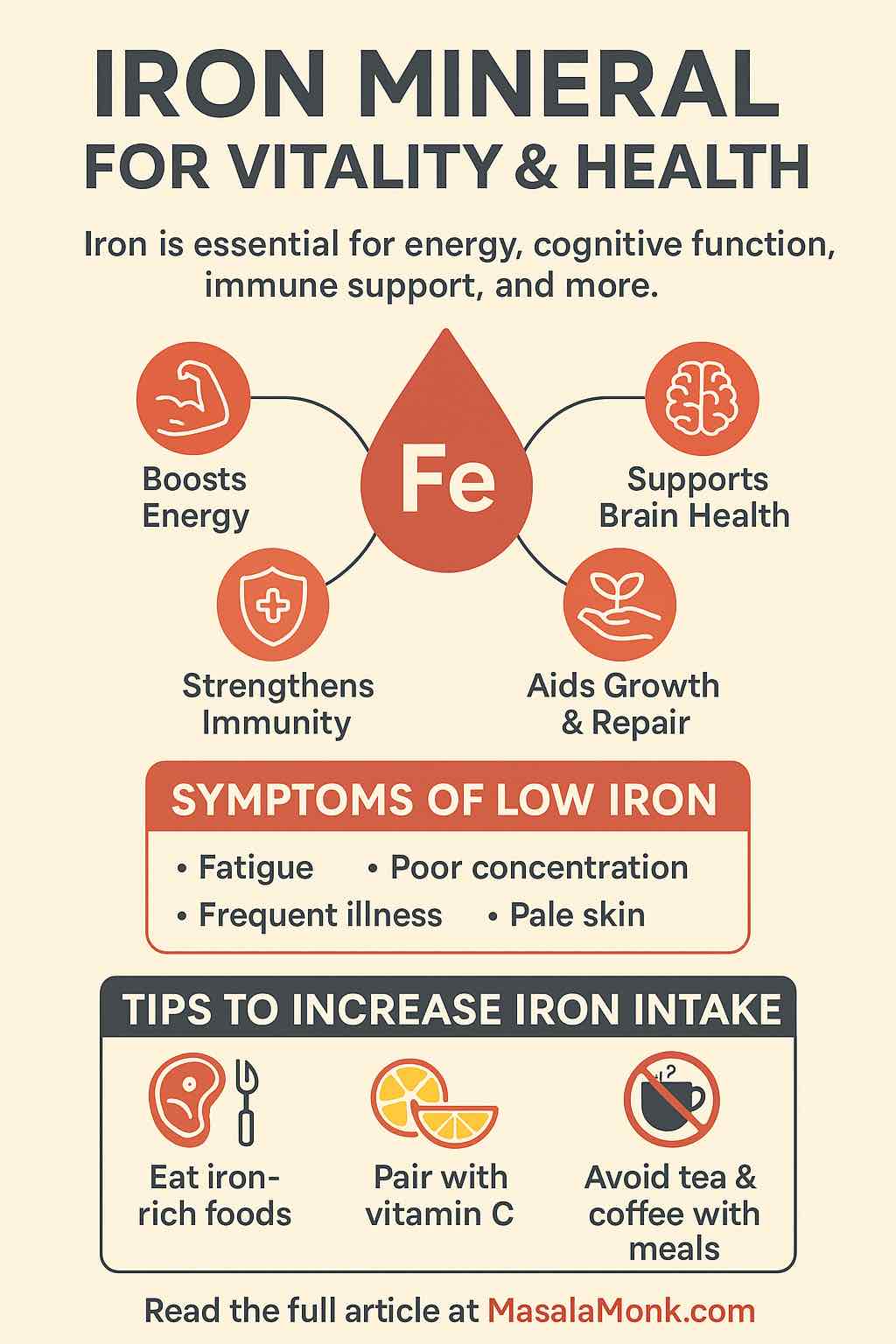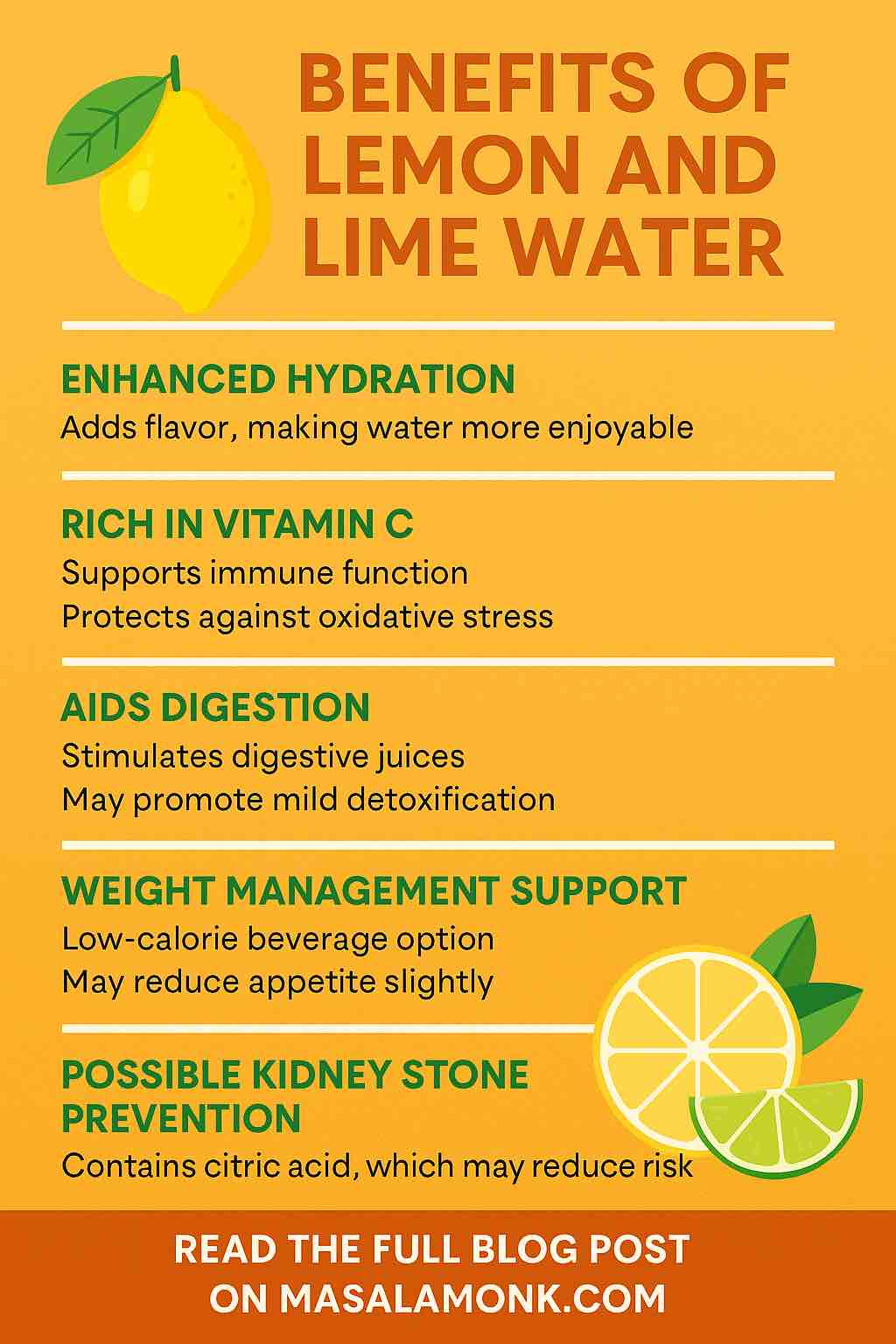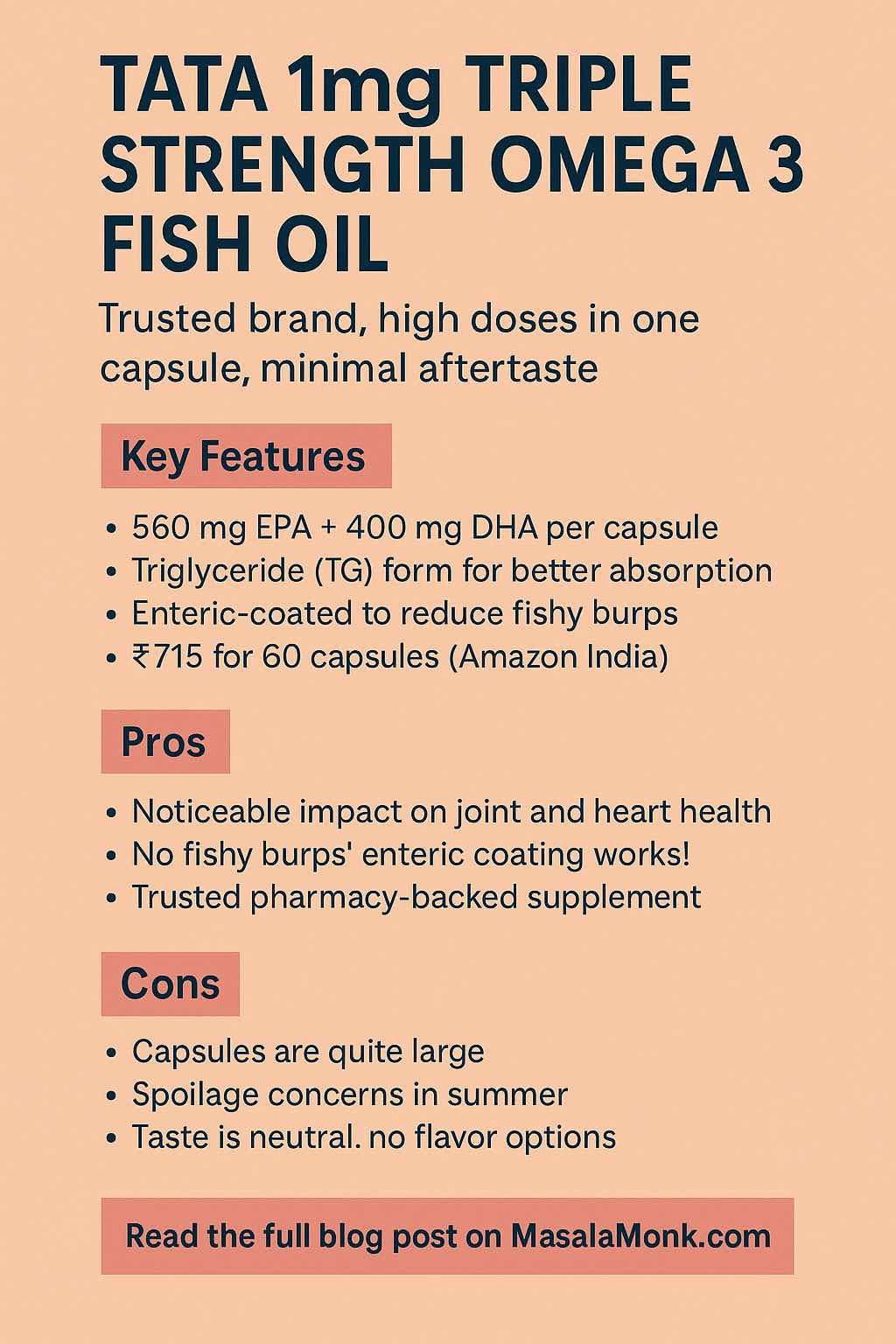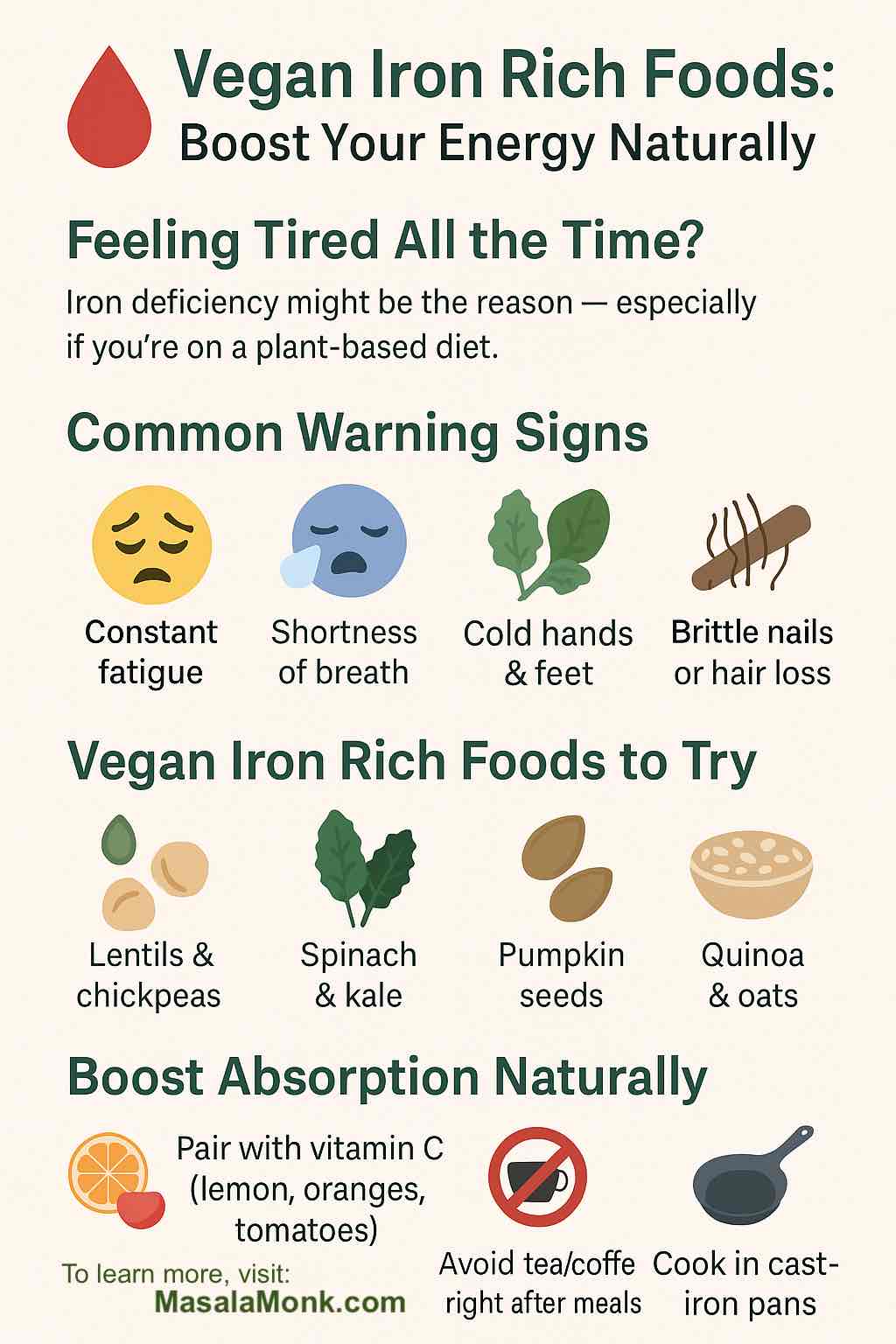
Iron is one of the most essential minerals for your body, and eating enough vegan iron rich foods is the key to staying energized on a plant-based diet. Iron supports the production of hemoglobin, the protein in red blood cells that carries oxygen throughout your system. Without it, your body can’t make enough healthy blood cells, which often leads to fatigue, weakness, and other health problems.
Iron deficiency is one of the most common nutritional issues worldwide. While anyone can be affected, vegans and vegetarians are at a higher risk since their diet relies entirely on non-heme iron from plants. The good news is that with the right food choices, it’s absolutely possible to meet your iron needs and keep your hemoglobin levels strong.
In this post, we’ll cover the most common symptoms of iron deficiency and then explore the top 10 plant-based iron sources that every vegan should know about — plus simple ways to improve absorption so your body makes the most of the iron you eat.
💡 Iron deficiency is the most common nutritional disorder worldwide, affecting nearly 2 billion people.
👉 Nutrition Journal – Springer
What Are the Common Iron Deficiency Symptoms?
Iron deficiency doesn’t usually strike overnight — instead, it builds up gradually. At first, the signs are easy to dismiss or mistake for stress, lack of sleep, or even aging. However, as time goes on, low iron begins to affect your red blood cells, which means less oxygen is carried to your organs and muscles. As a result, your body works harder to function, and that’s when symptoms start becoming more obvious.
So, what should you keep an eye out for? Let’s walk through some of the most common warning signs:
Constant Fatigue from Iron Deficiency
To begin with, one of the earliest and most widespread signs is ongoing fatigue. When your body can’t transport oxygen efficiently, you feel drained and sluggish — even after a full night’s rest.
Pale or Yellowish Skin Due to Low Hemoglobin
In addition to tiredness, iron deficiency reduces hemoglobin, which gives blood its red color. Consequently, skin may appear unusually pale or even slightly yellow, especially on the face, gums, or inner eyelids.
Dizziness and Frequent Lightheadedness
As oxygen levels continue to drop, the brain often doesn’t receive enough supply. Therefore, dizziness and lightheadedness — particularly after standing up quickly — are common red flags.
Shortness of Breath During Normal Activities
Similarly, low iron affects your muscles. Everyday activities like climbing stairs or taking a brisk walk may leave you short of breath, since your tissues aren’t getting the oxygen they need.
Unusual Cravings Linked to Iron Deficiency (Pica)
Interestingly, some people develop cravings for non-food items such as ice, clay, or even dirt. Known as pica, these unusual cravings are strongly linked to iron deficiency.
Brittle Nails, Thinning Hair, or Slower Growth
What’s more, iron is essential for healthy cell growth. When levels drop, nails may break easily, hair might thin or fall out, and overall growth can slow down noticeably.
Cold Hands and Feet from Poor Circulation
Finally, poor circulation caused by low iron often makes it harder for your body to regulate temperature. As a result, your hands and feet may feel cold even in warmer weather.
These are some of the more visible signals, but it doesn’t stop there. Iron deficiency can also lead to headaches, difficulty concentrating, or even heart palpitations. Unfortunately, many of these clues are overlooked until the condition becomes severe.
🔎 Science Says…
👉 To explore the full range of symptoms in detail, check out our in-depth guide here: Iron Deficiency Anemia Symptoms: 15 Signs You Are Iron Deficient
Why Focus on Vegan Iron Rich Foods?
Iron isn’t just another nutrient on the list — it exists in two distinct forms, and knowing the difference helps you make smarter food choices.
On one hand, there’s heme iron, which comes from animal sources such as meat, poultry, and fish. The body absorbs it fairly easily, which explains why people who eat meat often meet their iron needs without much effort.
On the other hand, plant-based eaters rely on non-heme iron, which is found in beans, lentils, leafy greens, and other vegan staples. The catch is that the body doesn’t absorb this form quite as efficiently. That’s why anyone following a vegan or vegetarian diet needs to be a little more intentional about their daily meals.
When it comes to daily needs, adults generally require about 8 mg for men and 18 mg for women of childbearing age. Since non-heme iron is absorbed less efficiently, people on plant-based diets are often advised to aim for almost double those amounts. This might sound like a lot, but with the right variety of foods, it’s absolutely achievable.
👉 Want to explore more about why this mineral is so essential for energy, blood health, and overall vitality? Take a look at our companion guide here: Iron: Mineral for Vitality and Health
🍊 Boosting Absorption
✨ Vitamin C can triple the absorption of non-heme iron from plant foods. A simple squeeze of lemon on your spinach can make all the difference.
👉 PubMed
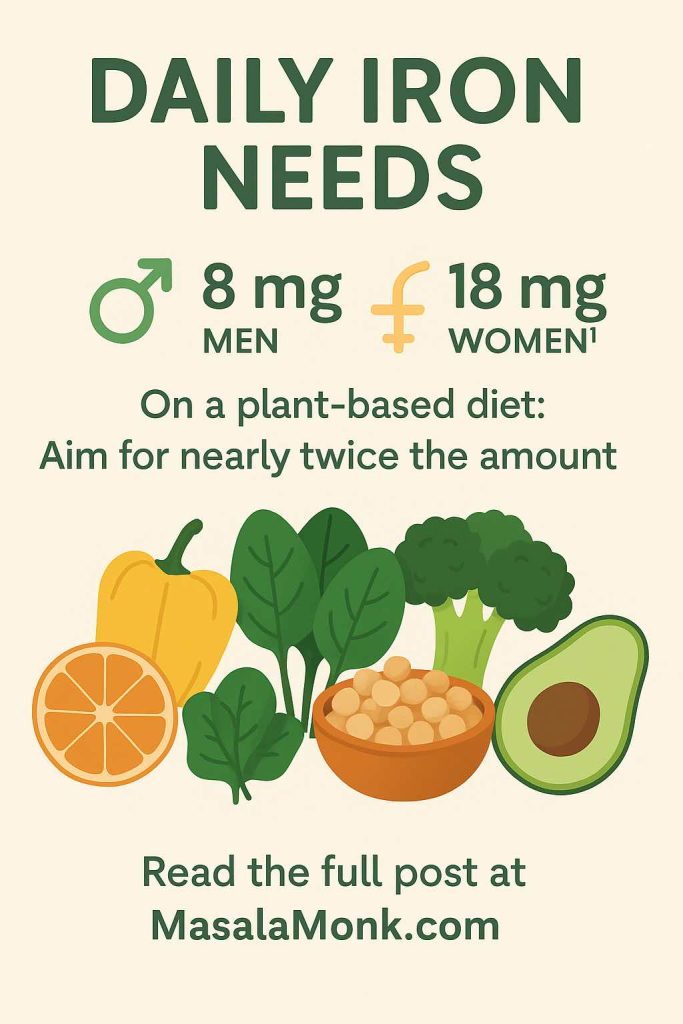
Top 10 Vegan Iron Rich Foods to Boost Hemoglobin
If you follow a plant-based lifestyle, knowing your best food sources of iron is key. Fortunately, there’s a wide variety of vegan iron rich foods that can keep your energy high, your hemoglobin strong, and your meals exciting. Let’s break them down by food group so it’s easier to add them to your daily routine.
🌱 Legumes and Pulses: Everyday Vegan Iron Rich Foods
Lentils and Beans – Classic Vegan Iron Foods
Lentils provide about 6–7 mg of iron per cooked cup, making them one of the top vegan iron rich foods. Black beans, kidney beans, and navy beans are also excellent sources. Because they’re hearty and versatile, you can enjoy them in soups, stews, or even refreshing salads.
Chickpeas – Protein-Packed Vegan Iron Source
With 4–5 mg of iron per cup, chickpeas (garbanzo beans) deserve a regular spot in your diet. You can roast them for a crunchy snack, whip them into hummus, or toss them into curries and Buddha bowls.
Tofu and Tempeh – Plant-Based Iron Rich Foods
Soy products like tofu and tempeh deliver 3–5 mg of iron per 100 g. Tofu absorbs flavors beautifully, while tempeh’s nutty taste and probiotic benefits make it a favorite in stir-fries, marinades, or sandwiches.
🥬 Leafy Greens and Vegetables: Vegan Iron Rich Vegetables
Spinach and Dark Leafy Greens – Powerful Plant Iron Sources
Spinach, kale, collards, and Swiss chard all pack around 2–3 mg of iron per 100 g. When paired with vitamin C foods like lemon or strawberries, their non-heme iron becomes much easier to absorb.
Beetroot – A Blood-Boosting Vegan Iron Food
While beetroot only has about 1 mg of iron per 100 g, it supports circulation and blood flow. Roasted, juiced, or grated into salads, it’s an easy way to complement other vegan iron sources.
🥜 Nuts and Seeds: Small But Mighty Vegan Iron Foods
Pumpkin Seeds – One of the Best Vegan Iron Rich Foods
Pumpkin seeds (pepitas) are iron powerhouses with nearly 9 mg per 100 g. Sprinkle them on oats, blend them into smoothies, or snack on them roasted with sea salt.
Cashews and Almonds – Plant-Based Iron Foods for Snacking
Cashews and almonds provide 2–6 mg of iron per 100 g, while also giving you healthy fats and protein. From creamy cashew sauces to simple almond butter toast, they make adding iron to your diet delicious and effortless.
🍑 Fruits and Dried Fruits: Naturally Sweet Vegan Iron Rich Foods
Dried Apricots and Raisins – Easy Vegan Iron Snacks
Dried fruits like apricots and raisins contain 2–3 mg of iron per handful. They’re portable, pair well with nuts, and double as natural sweeteners in salads, oatmeal, or baked goods.
🌾 Grains and Everyday Staples: Iron Rich Vegan Grains
Quinoa – A High-Protein Vegan Iron Grain
Quinoa not only provides about 2.8 mg of iron per cooked cup but is also a complete protein. It works as a base for grain bowls, salads, or even breakfast porridge.
Oats and Whole Grains – Daily Plant-Based Iron Sources
Oats, brown rice, and whole wheat all deliver 2–4 mg of iron per serving. Starting your morning with oatmeal topped with pumpkin seeds and raisins is a tasty way to keep iron levels up all day.
💡 Quick tip for variety: Mix and match across categories. A quinoa salad with chickpeas and spinach, topped with pumpkin seeds and dried apricots, isn’t just delicious — it layers several vegan iron rich foods in one meal, giving you a serious nutrient boost without extra effort.
🥬 Plant-Based Iron Facts
🌱 Studies show vegans often have lower ferritin levels than meat-eaters, which makes mindful intake of vegan iron rich foods crucial.
👉 National Library of Medicine (PMC)
How to Improve Iron Absorption Naturally
Eating plenty of vegan iron rich foods is a great start, but how well your body absorbs that iron makes all the difference. The good news is that with just a few small tweaks to your daily routine, you can help your body make the most of every meal.
One of the most effective ways is to pair iron foods with vitamin C. Adding citrus fruits, bell peppers, tomatoes, or strawberries alongside your meals can dramatically increase absorption. For example, a spinach salad with orange slices or lentils with fresh tomatoes works perfectly.
It also helps to limit tea, coffee, and red wine right after meals. These drinks contain tannins and polyphenols, which interfere with iron uptake. To get the most from your plant-based iron sources, enjoy them between meals instead.
Another simple tip is to cook in cast-iron pans. This old-fashioned practice can naturally increase the iron content of your meals, especially when preparing acidic dishes like tomato sauces or curries.
Also Read: Buying a Cast Iron Skillet? 5 Warnings Before You Invest
🥄 Everyday Hacks
🍳 Cooking in cast-iron pans can increase the iron content of food naturally, especially when preparing acidic dishes like tomato sauce.
👉 VeganHealth.org

Easy Vegan Iron Rich Meal Ideas
Putting good nutrition into practice doesn’t have to be complicated. With a little planning, you can enjoy simple, tasty meals that are rich in plant-based iron and easy to prepare.
For breakfast, try overnight oats topped with pumpkin seeds, dried apricots, and fresh orange slices. This combination provides iron, fiber, and a vitamin C boost to improve absorption.
At lunchtime, a quinoa and chickpea salad with spinach, bell peppers, and a zesty lemon dressing makes a colorful and nutrient-packed option. It delivers protein, iron, and vitamin C in one bowl.
Dinner could be a comforting stir-fry of tofu, kale, broccoli, and brown rice. This meal is both hearty and rich in iron, helping to keep hemoglobin levels strong.
For snacks, keep roasted chickpeas on hand or prepare a trail mix with almonds, raisins, and pumpkin seeds. These convenient bites are portable, delicious, and packed with iron.
For some inspiration, do read 5 Iron-Enriched Smoothies for Pregnancy with Spinach and Apple and 5 Iron-Boosting Vegan Snacks for Pregnancy: Lentil and Spinach Combinations – though these posts were written with Expecting moms in focus, however the food items are Iron rich and can be consumed to boost iron naturally for everyone, pregnant or not.
⚖️ Heme vs. Non-Heme Iron
📊 Research confirms non-heme iron (from plants) is absorbed less efficiently than heme iron (from meat), but pairing with vitamin C helps close the gap.
👉 ScienceDirect
Final Thoughts
Iron deficiency may be common, but the good news is that it’s both manageable and preventable. By recognizing the early warning signs and making space for more vegan iron rich foods in your daily meals, you can boost hemoglobin levels, fight fatigue, and strengthen your immunity. Small changes truly add up when it comes to long-term health.
If you’d like to dive deeper into the symptoms, be sure to read our detailed guide here:
👉 15 Signs You Are Iron Deficient
And if you’re curious about just how vital this mineral is for your energy, vitality, and wellbeing, don’t miss this piece:
👉 Iron: The Mineral for Vitality and Health
With awareness and the right food choices, staying iron-strong on a vegan diet is absolutely possible. 🌿💪
FAQs on Iron Deficiency & Vegan Iron Rich Foods
1. What are the first signs of iron deficiency?
Iron deficiency usually starts with subtle symptoms like fatigue, pale skin, and frequent dizziness. Over time, these can progress into anemia if untreated. That’s why it’s important to recognize the signs early and adjust your diet.
2. Can vegan iron rich foods really prevent anemia?
Yes, absolutely. While plant-based sources contain non-heme iron (which absorbs less efficiently), pairing them with vitamin C-rich foods can significantly boost absorption and help prevent anemia.
3. Which vegan foods are the highest in iron?
Lentils, chickpeas, spinach, pumpkin seeds, quinoa, and tofu are among the top vegan iron rich foods. Adding a mix of these to your daily meals ensures steady iron intake.
4. How much iron do vegans need daily?
The recommended daily intake is about 8 mg for men and 18 mg for women of childbearing age. Since non-heme iron is absorbed less efficiently, vegans are often advised to aim for nearly double these amounts.
5. Does cooking in cast iron pans increase iron levels in food?
Yes, it does. Cooking in cast iron can naturally add small amounts of iron to your meals, making it a simple way to boost intake alongside vegan iron rich foods.
6. What should I avoid when eating iron-rich meals?
Certain compounds in tea, coffee, and red wine can block iron absorption. It’s best to enjoy these drinks at least an hour before or after your meals.
7. Are iron rich fruits effective for boosting hemoglobin?
Yes, fruits like dried apricots, raisins, and prunes are good plant-based sources of iron. Since they also contain vitamin C, they help improve absorption, making them a double win.
8. How long does it take to recover from iron deficiency with diet changes?
It varies. Some people notice improvements in energy within a few weeks, while for others it may take a few months. Consistency with vegan iron rich foods and healthy habits is key.
9. Can iron deficiency affect hair and nails?
Yes. Brittle nails, thinning hair, or slow hair growth are common signs of iron deficiency, as iron plays a role in healthy cell and tissue development.
10. What are some easy vegan meals to improve iron intake?
Great examples include lentil curry with spinach, quinoa and chickpea salad, tofu stir-fry with broccoli, and overnight oats with pumpkin seeds. Simple, tasty, and iron-rich.
References & Further Reading
For those who want to explore the science behind vegan iron rich foods, iron absorption, and iron deficiency, here are some trusted resources:
- Global prevalence of iron deficiency – Nearly 2 billion people worldwide are affected, making it one of the most common nutritional deficiencies. Nutrition Journal – Springer
- Vegan and vegetarian iron status – Research confirms that people following vegan diets often have lower ferritin levels compared to omnivores, highlighting the importance of mindful food choices. National Library of Medicine (PMC)
- Heme vs. non-heme iron absorption – Plant-based non-heme iron is absorbed less efficiently than heme iron from animal foods, making food combinations essential for vegans. ScienceDirect
- Vitamin C improves non-heme iron absorption – Studies show that vitamin C dramatically boosts iron absorption and even offsets the effects of dietary inhibitors. PubMed
- Best practices for vegans – Learn more about iron inhibitors like tea, coffee, and calcium, and how strategies like cooking in cast iron pans can naturally boost iron intake. VeganHealth.org

